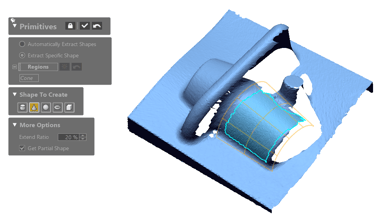In today's engineering and manufacturing landscape, two technologies stand out for their transformative potential: reverse engineering and 3D scanning. Whether you're an entrepreneur launching a new product or a seasoned engineer refining existing designs, understanding the interplay between these technologies is essential for optimizing your workflow and achieving precision in your projects.
What is Reverse Engineering?
Reverse engineering is the process of dissecting a physical object to recreate it in a digital environment. This can be done using various methods, from traditional hand measurements and technical drawings to advanced metrology tools that capture minute details with extreme accuracy. The goal is to produce a solid, editable CAD model that is the foundation for design modifications, analysis, and manufacturing.
At CADmore, we employ state-of-the-art tools such as blue light lasers and CT scanners to conduct reverse engineering with unmatched precision. These technologies allow us to create highly accurate digital replicas of even the most complex components, which can then be modified, optimized, or reproduced. This capability is particularly valuable for industries dealing with obsolete parts or modifying existing designs without original documentation.
The Role of 3D Scanning in Reverse Engineering
3D scanning is a non-contact, highly accurate method of capturing the geometry of a physical object. The result is a detailed mesh file that represents the object's surface in precise detail. Unlike traditional measurement methods, 3D scanning captures even the most intricate features, making it an indispensable tool for reverse engineering.
Blue light laser scanning, a specialty at CADmore, is particularly effective for capturing fine details and complex geometries. This scanning method uses structured light to measure the object's surface, creating a high-resolution point cloud that can be converted into a mesh. Although this mesh isn't directly editable like a CAD model, it serves as a critical reference for reverse engineering, ensuring that every detail of the original object is preserved in the final model.
Integrating Reverse Engineering and Scanning
While reverse engineering and 3D scanning are distinct processes, their combined use can significantly enhance design and manufacturing workflows. Scanning provides a quick and accurate way to capture the physical object, which can then be used to inform the reverse engineering process. This integration is particularly useful in industries where precision is paramount, such as aerospace, automotive, and medical devices.
For example, in reverse engineering a replacement part, the scanning process can quickly capture the worn or damaged part's geometry. This data is then used to reconstruct the part in a CAD environment, which can be refined and optimized before manufacturing. By using both technologies together, you not only save time but also ensure that the final product is as accurate as possible.
Key Differences and Synergies
Understanding the differences between reverse engineering and 3D scanning is crucial for selecting the right approach for your project. Reverse engineering focuses on creating parametric, editable models essential for design changes, simulations, and manufacturing. This process involves more advanced software and expertise to convert physical data into a fully functional CAD model.
On the other hand, 3D scanning excels at quickly capturing an object's exact shape and details. While not directly editable, the resulting mesh file provides a highly accurate digital representation of the object. This mesh can be used as a reference for reverse engineering or as a basis for quality control, simulation, or rapid prototyping.
The synergy between these technologies lies in their complementary nature. While scanning provides the raw data, reverse engineering transforms it into a usable model. This combination is particularly powerful when working with complex geometries or when a high level of accuracy is required.
Practical Applications and Considerations
When deciding between reverse engineering and 3D scanning, it's essential to consider your project's specific needs. If you require a detailed, editable model for design modifications or manufacturing, reverse engineering is the best choice. This process is ideal for creating new parts, modifying existing designs, or producing digital documentation for legacy components.
Alternatively, if you want to capture an object's physical dimensions and details quickly, 3D scanning is the way to go. This approach is particularly useful for creating detailed digital twins, conducting quality inspections, or preparing models for simulation and analysis.
In many cases, the most effective approach is to use both technologies in tandem. This allows you to leverage the strengths of each method, ensuring that your project is completed with the highest level of accuracy and efficiency.
Conclusion: Unlocking the Full Potential of Modern Engineering
In the evolving world of engineering and manufacturing, reverse engineering and 3D scanning are not just tools—they are enablers of innovation and precision. By understanding the capabilities and applications of these technologies, you can make informed decisions that optimize your processes and drive your projects forward.
Whether you're looking to recreate an obsolete part, modify an existing design, or simply explore the possibilities of modern manufacturing, CADmore is here to help. Our expertise in reverse engineering and 3D scanning ensures that you receive the highest quality results, tailored to your specific needs.
For more information or to discuss how we can assist with your project, schedule a consultation with CADmore. Let us help you navigate the complexities of modern engineering and unlock the full potential of your designs.